Rayong Botanic Gardens
And an existential encounter with monks
The day that I went to Rayong Botanic Gardens was one where I experienced lots of “firsts.” And not just in relation to the gardens. To put it in context, Rayong City is very different from the other places that I have been to in Thailand, mainly because there are no tourists; or at least no obvious tourists. I was there two nights and didn’t see another non-Asian person. There is also very little English, either spoken, or in terms of signage, so this really did feel like a first in Thailand for me. All the other places I have been to in this lovely country, before and since, are totally tourist-focused. The Thais are super-organised, packing us up like parcels and moving us here and there by all sorts of means possible; it makes most of Thailand a very easy place to be.
But Rayong city was something else. I was staying in the interesting old Chinese area, albeit in a small modern-ish hotel. It was the sort of place where people looked slightly askance at me as I walked around, because, I suppose, it was unusual me being there. This was a first in Thailand for me - to be stared at, however, politely.
The old Chinese quarter of Rayong City
Trying to organise to get out to Rayong Botanic Gardens, which no one had heard of and which to be fair, is in the back of beyond, was particularly difficult. No Grab Taxis (Thailand’s Uber equivalent) would take me, I think because it was too far. Rayong is not the sort of place that you can just wave a cab down, at least I didn’t see any cabs and I was told that it was not possible to get a cab on the street. But eventually, with a great deal of help from the lovely hotel staff, I managed to get a private taxi out there, albeit for a small fortune.
The cab driver understood a little English and I asked her whether it was common for women to drive taxis here and she said that it was, and that it had been her job for 4 years. I told her that it was virtually unheard of for a woman to drive a cab in the UK and she was very surprised: “I thought the UK advanced for women,” she said. I laughed and said in some ways it is, but not in others. I starting thinking how un-advanced a Friday night out in Manchester might seem to people here; more like the fall of the Roman Empire. Here in Thailand everyone seems to be so calm and civilised; I had yet to see any Thai people drunk, falling over, shouting or arguing.
“What about if women want a woman driver?” my taxi driver asked me, “For safety reasons? I explained that it wasn’t really an option. I said it probably wouldn’t be safe for a woman to be a taxi driver in the UK. She looked shocked. I explained about people being drunk in the UK and cabbies having to put up with all sorts. I remembered the all-female taxi firm, Elle’s Belles, who worked out of Hulme in the mid 1990’s. They were as tough as old boots and had a few tales to tell. Unfortunately they didn’t last. But surely a taxi service for women by women must exist somewhere in the UK. “Is there a problem for women getting taxis here driven by men?” I asked my taxi driver. She said that it could be a problem and that it is best to choose a woman driver which is an option on Grab. This hadn’t occurred to me before. I then remembered reading Michelle Roberts’ brilliant memoir of the 1970’s, Paper Houses, in which she describes how she arrives in Bangkok and gets in a taxi and the driver takes her miles from where she asked to go; she was virtually kidnapped as soon as she got off the plane. Somehow she insisted that he take her back and he did.
In any event, I arrived safely at Rayong Botanic Gardens and this was most definitely a first, as it is basically one large beautiful swamp. At more than 1500 acres, the thing that you initially see what appears to be an enormous lake of water lilies. The gardens are free to enter, but for 100 baht (£2.20), you get given a kayak, a life-jacket and a paddle, and before you know it, you are pushed off a little jetty and paddling through a Monet painting. I asked if there was a route I should take but was just waved away. No signs or rules or regulations; you can just row away and disappear.
Apart from the gentle lapping of my paddle in the water, it was so quiet and serene that I completely lost track of time as I went along, marvelling at how wonderful it all was.
The water was dark but clear and you could see right down to the mass of lily roots below the surface. In places it was so thick with these flowers, that you had to just row over them, which I was a little reluctant to do at first, but they just bobbed up again behind me, seemingly unperturbed. They were mainly Nymphaea nouchali (Blue Lotus) and Nymphaea rubra. The lily leaf edge is slightly crenellated and upturned; the flowers are various shades of purple and pink. And there was literally thousands of them!
Nymphaea nouchali (Lotus flower)
I just drifted on feeling other-worldly, up the river, completing losing all sight of the jetty. Bright red and turquoise dragonflies chased each other around my kayak and a cormorant stood sedately on the highest tree it could find, purveying its territory. Only a white stalk kept me company, wading delicately in the shallows, step by slow step, like a fragile old woman. After a while, I suddenly realised how far I had gone up the river; I had completely lost track of time being so immersed in this watery world. But despite being well over the hour that I was given to bring the kayak back, no one seemed the slightest bit bothered.
Up river in Rayong Botanic Gardens
Back on dry land, I had some late breakfast of two soft-boiled eggs (no egg cups, toast, salt or pepper, so a slightly odd meal), along with a cup of black tea. I then headed into the other area of the gardens; an ancient, swampy forest. For this I hired an old mountain bike for 50 baht.
Rayong Botanic Garden Cafe
The forest is arranged around three large islands, interspersed with swamps, lakes and rivers. A relatively good path allows you to cycle around easily enough, although it became quite a maze of paths and bridges and I found it impossible to get a mental map of the place in my head.
The small trees that dominate this ancient wetland forest are Melaleuca cajupita and Melaleuca quinquenervia, the latter being commonly known as the Paperbark Tree, the Punk Tree or Niaouli. Niaouli is the essential oil, similar to tea tree oil, that comes from the leaves of Melaleuca quinquenervia and which has various useful properties such as an antiseptic, an acne cream and a decongestant. A member of the myrtle family, the most startling thing about these small trees are their beautiful, soft papery bark, which flakes off the trunk in creamy white and beige shavings. Their crooked and twisting branches give them the appearance of being timeworn. But the reason for it being known as an ancient Samet forest is because previously these trees used to grow all over this region, and in particular along the coast of Ko Samet, the lovely island near by where I had just spent a couple of very relaxing days on the beach. Unfortunately the paperbarks are less common there now, mainly due to the extensive coastal development. But they are tough little trees and can withstand both floods and droughts and they were doing very well in this protected area.
The Ancient Samet forest with Melaleuca sp. The Paperbark tree
The forest felt slightly apocalyptic as well as ancient. Despite being in 21st century Thailand, I was reminded of Paul Kingsnorth’s novel, The Wake, which is set in the Lincolnshire fens during the Norman invasion. This forest was just like his descriptions of the marshy swamps that his protagonist, the outlaw, tramps through on his way to exact some revenge. What a great set this would be for the film of the book, I thought. It was both beautiful and slightly bizarre; at one point I found myself in the middle of a swarm of almost bird-size, black butterflies, who didn’t seem in the least bothered to have me amidst their centre. Trees shrouded in bright green, moss cloaks were like giant wizards looming over me, whilst the reflections of the Paperbarks in their sun-dappled watery beds, made it all quite mysterious and magical.
Moss covered trees in the forest
One of the areas of the forest had a large sign with a list of carnivorous plants allegedly growing there. This was very exciting and I got off the bike and started moving deeper into the forest to search for them. I found literally hundreds of Nepenthes mirabalis (the Swamp Pitcher Plant); they were everywhere, climbing up trees, hanging down from branches, crawling along the ground. Their upper pitchers often contained the poor body of a beetle or fly who had been enticed into the cup, only to find themselves trapped inside where they were drowning in the digestive cocktail of enzymes. Nepenthes need the proteins from these insects as they generally grow as epiphytes (on other plants) or on very poor soil where there are limited nutrients.
Nepenthes mirabalis (Swamp Pitcher Plant)
Beetle drowning in pitcher cup
Unfortunately, despite extensive searching, I couldn’t find any of the other carnivorous plants listed on the board, which included Sarracenia purpurea, (the Purple Pitcher Plant), Drosera capensis (sundew) or Dionaeas, (Venus Flytraps). After quite a time of virtually crawling around on the forest floor looking for them, I suddenly thought of snakes and made a quick exit back to the bike and the path.
I spent quite a while cycling around this fabulous forest, over little bridges, and had a look at the salt lick, which is where animals come to drink. I then suddenly felt very hot and tired and concerned that I was low on water ands so decided to call it a day here. I was pleased that I had taken the taxi driver’s number, and I didn’t have to wait too long for one of her colleagues to come and pick me up.
Bridge between islands in the Ancient Samet Forest
Back in Rayong City, I was hungry after all the mornings business of getting to the botanic garden, rowing and cycling and then getting back, all on just two eggs. I had a few hours to kill before getting the night bus to Chiang Mai, so I went to check out the local food hall. A large open-sided market with lots of stalls, plastic tables and stools, it was, however, quiet, being around 3.30 pm and not really anyone’s dinner-time, except mine. I sat down to some spicey chicken and rice dish, and as I was eating I became aware of a strange voice from the shadows at the edge of the dim hall. The lights were still off and very little sunlight could reach that part, so it was hard to see who was speaking. I sort of tried to ignore it, but as my eyes became used to the darkness, I made out the figure of a man, half-hidden behind one of the pillars. I couldn’t really see his face, but just that he was wearing long, bright blue shorts and a large-rimmed straw hat. He appeared to be talking to me whilst making an annoying clicking noise. I looked around to see if anyone else was taking any notice of him, which they weren’t, so I decided to just get on with my dinner which I finished without further ado.
I then took a walk down to Wat Pa Pradu, the local temple, which boasted a very rare left-reclining Buddha, possibly the only one in the world. I entered the Wat and found the statue, which actually appeared to be shuddering; his “skin” seemed to be alive and moving. On closer examination I realised that the gold paint was peeling off the statue and the breeze that came in to the temple gave it the shimmering, shaking affect.
It was very quiet in the Wat and I enjoyed pottering around and then was pleased to discover a tiny cafe just inside another entrance; a good place to waste a bit more time I thought. And I was desperate for a cup of tea. A little puppy was yapping about inside. It was so small, fluffy and silly-looking, that at first I had thought it wasn’t real. It jumped up and down on all fours like a wind-up toy. There was no one else in the cafe except the woman serving. But after a short while a monk, probably around 30 years old, came in. Barefoot, shaven-headed, in his orange robes, he picked up the puppy and sat next to the window, petting it. He said something to the woman, but didn’t appear to order any food or drink.
As I watched him play with the puppy, I realised that beyond him, sitting outside on the steps across from the cafe, staring very intently straight in at me, was the man who had been lingering in the shadows at the food hall. I had to double-check with myself that I wasn’t imagining it, but the bright blue shorts and the large straw hat were very distinctive. I wondered how long he had been there. And was he looking at me or at the monk? Somehow, it seemed most definitely that it was me.
I sat there, sipping my not very pleasant, dark green-coloured tea, looking at the monk playing with the puppy and trying not to look beyond him through the window at Blue Shorts Man. I didn’t want him to think that I was bothered by him. Neither the monk, nor the woman quietly busying herself behind the counter, gave any indication that they had noticed him, despite it feeling to me that the four of us were the only people in the whole Wat, if not in the whole world. I could see on the glass door that the cafe closed at 5.00 pm. It was now twenty to.
The time ticked by and nothing happened; the monk continued quietly petting the dog; Blue Shorts Man sat there outside, absolutely still, staring in; the woman leant against the counter, no longer busy, reading something on her phone. I felt like I was in some sort of absurd, existential play, where we were all waiting for something to occur. Waiting for Godot! I became aware that at some point quite soon, I was going to have to make a decision, because the cafe was going to close. But what to do exactly, I wasn’t sure. Had I got a stalker? If I left the cafe, would Blue Shorts follow me? Was he dangerous? Should I try and talk to the woman about him? But I did nothing for the time being, and we all carried on sitting in silence in our designated roles. The monk had placed the puppy on the table in front of him and was just staring at it, and even the puppy went quiet, looking over the edge of the table, seeming to contemplate whether it was too far to jump down.
Suddenly the door opened and Godot appeared; a younger monk, he came in and said something to the first monk. Then, to my great surprise, he turned and started talking to me, in Thai. Of course I had no idea what he was saying. He had his back to the window and made no gesture to anything or anyone else. He then appeared to be waiting for an answer. I apologised and said I didn’t understand. He then said in English: “You should take care of him.” He could probably see my mind ticking away, trying to unravel what he meant by this. Was he referring to the man outside? Did he mean I should take care of Blue Shorts by giving him something? I glanced over to the window and said: “Excuse me, do you mean him?” The monk did not follow my gaze or give any indication that there was another character in this play at all. He said again: “You should take care.” And then: “Of him.” The other monk meanwhile just sat and did not look at me, or engage at all in this strange conversation. I said: “I think you mean the man outside. I think he is a problem. He was bothering me in the food hall.” “Yes,” the young monk said, "We know. He has followed you round this temple. We watched him. You need to take care.”
I then suddenly realised that they were all way ahead of me. I had been totally oblivious to Blue Shorts following me round the Wat, even though it had been virtually empty. He must have been hiding behind more pillars as I went round. And the monks were following him, following me. And it seemed to be now that possibly the whole reason for the first monk to be in the cafe had been to keep an eye on me and make sure that I was safe from Blue Shorts.
The second monk then said, “I will tell him to go away if you want me to.” I nodded appreciatively: “Yes please. That would be very helpful. Thank you.” And with that, the young monk went outside and said something to Blue Shorts and pointed towards the entrance. Blue Shorts got up quickly, and appeared to remonstrate with the monk for just a second, before scurrying away. My saviour came back into the cafe and I thanked him. He said to me, as if to apologise on the man’s behalf: “He is drunk and not well.” He pointed to his head to suggest that he, Blue Shorts, was mentally unstable. I thanked him again for his help. I was indeed very relieved and grateful.
As it was now 5.00 pm, I thought I had better go, perhaps using the other exit. However, the monk then said that I should not walk back to the hotel alone and he asked me where my hotel was. I tried to explain that it was quite near by and that I would be fine but he insisted that I give him the name of where I was staying. I bought it up on my phone and the monk got out a piece of cloth and asked me to place my phone on it. He clearly wasn’t allowed to touch my phone as I had touched it. He then went outside with it, and before I knew it, three security guards turned up outside, one with a motorbike. The monk showed them my phone and then bought it back to me, still on the cloth. He insisted I get on the back of the bike belonging to the security guard. I thanked him again, and before I knew it, I had been transported back to the safety of my hotel lobby. I could now relax and hang around before the long journey up to the north.
So this was my first proper encounter with monks, and what lovely young monks they were to take care of someone like me who stuck out like a sore thumb in Rayong. First the magical botanic gardens and then the strange goings on in the Wat, what an unusual and interesting day it had been.





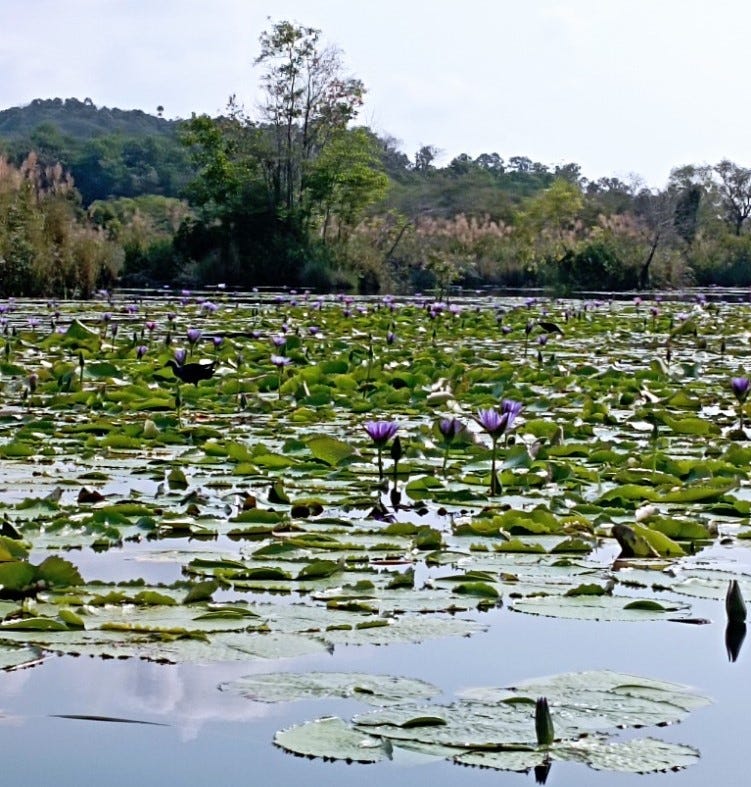


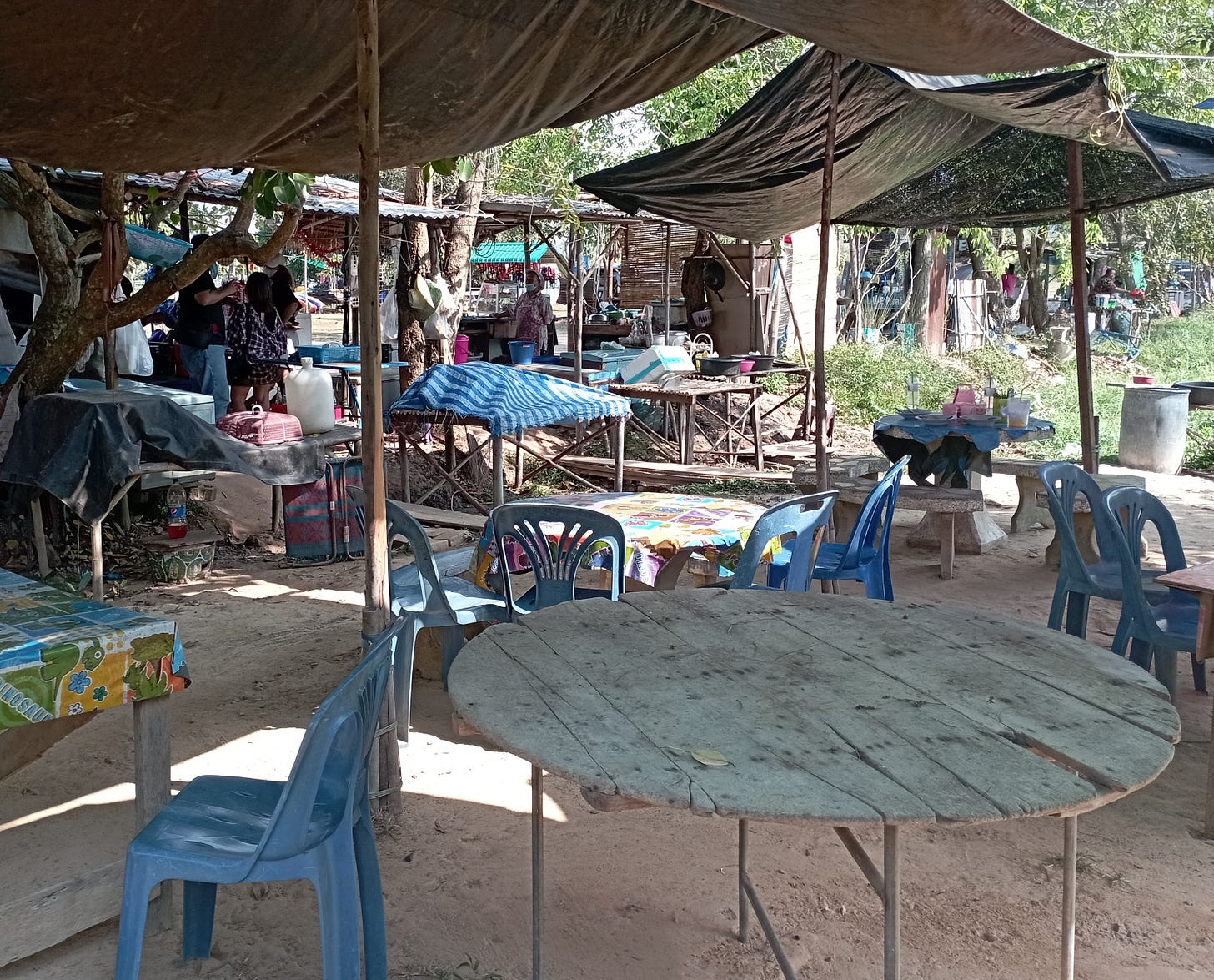
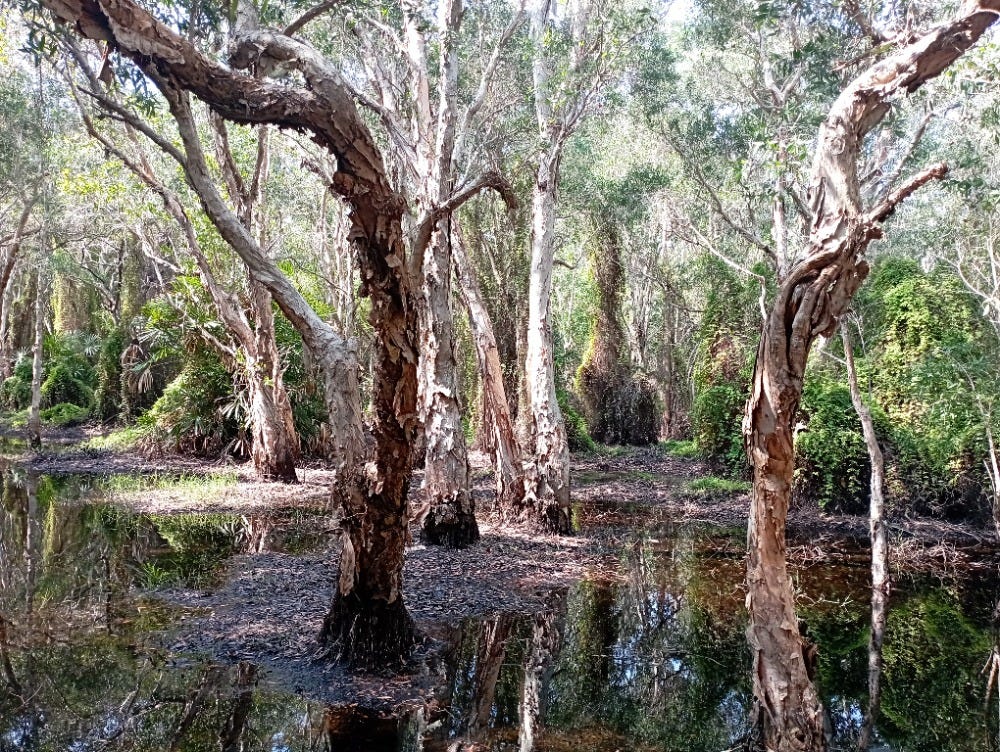

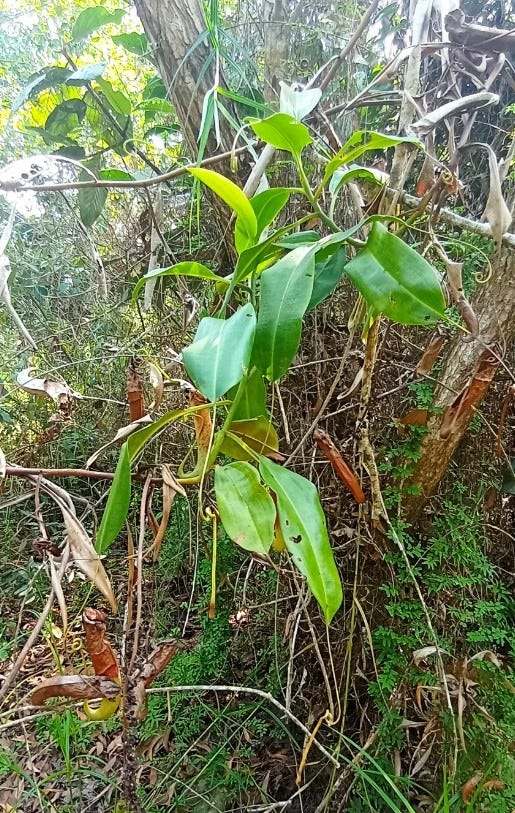
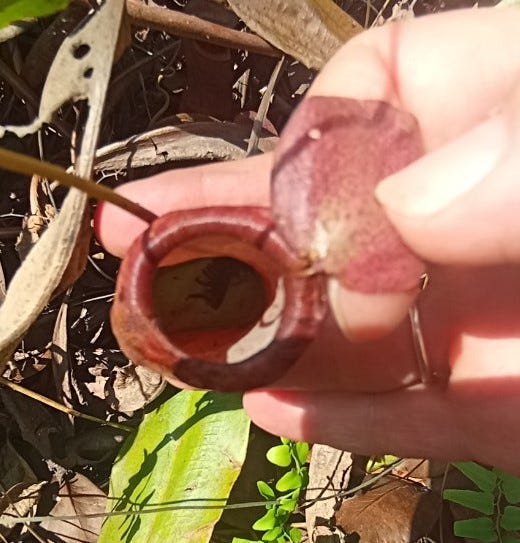
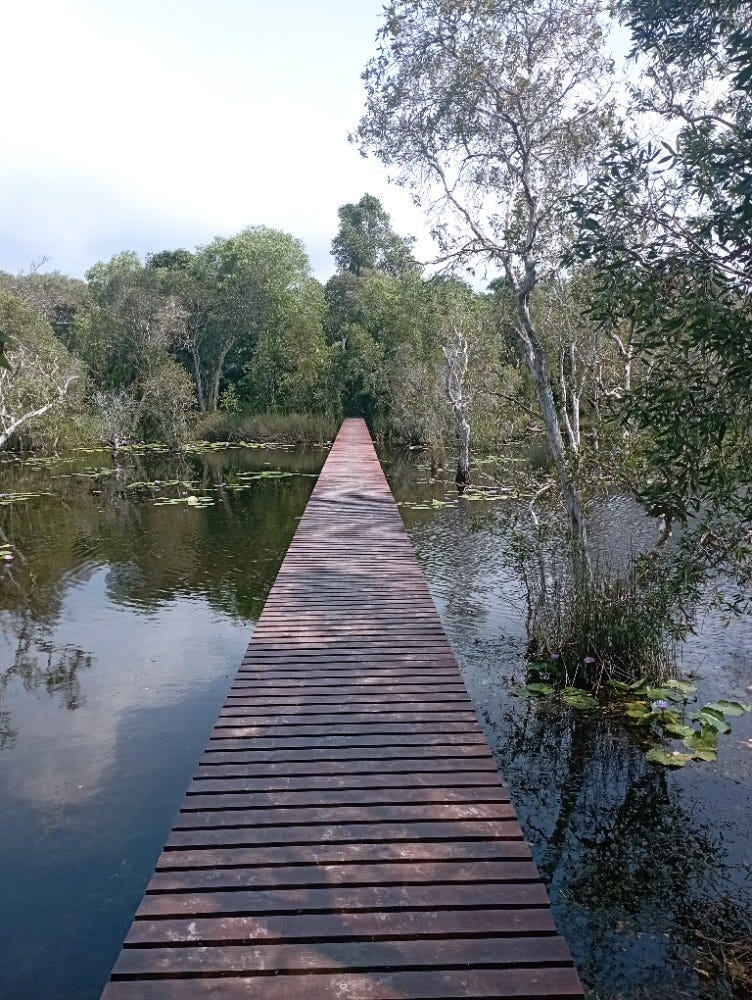
I know! It was all very odd but lucky to be rescued by monks!
Blimey Laurel, you are having some adventures! Thank goodness Godot turned up!!